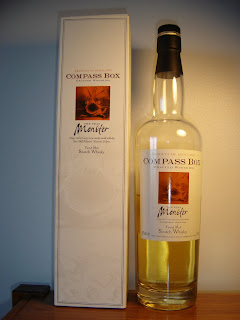
As discussed in the last post, single malt and blended whiskies do different things well. Even if you are a die-hard (yippee-kay-ay) single malt fan, before you turn a blind eye to all blended whiskies, consider what is composing the blend. If the taste of whisky made from anything other than barley does not appeal to you, the average blend will probably not be to your liking. If you're seeking a smooth, balanced whisky that works well in mixed drinks and does not have any strong particular flavour characteristics, your palate and pocketbook will thank you for choosing a blend! That being said, there are aged blends out there that can get pretty pricey - check out Johnnie Walker Blue Label and older Chivas Regal blends. A large part of the reason these guys are so expensive is that they contain some really nice old malts which can be difficult to find on their own.
It is important to keep in mind that almost all whiskies, including single malts, are blends of whisky of different ages, and from different casks (unless they state otherwise). The practice of mixing or blending is an important way for distilleries to obtain consistency in their product year after year. For whiskies designated as single malts, only product from that particular distillery is used. Let's take Ardbeg 10 y-o as an example. Although it has an age statement of 10 years, in reality it is a blend of Ardbegs of various ages. By law, the age statement given on the bottle has to refer to the youngest whisky added to the blend. Thus, there may be older whisky in there, but the youngest whisky is 10 y-o. Older whisky is generally more mellow (see the Wood, Wine and Whisky posting) and can therefore be used to help balance or counteract the strong character of a younger whisky. It is in the best interest of the distillery to maintain consistency in their product, thereby keeping their loyal customers satisfied. This means that you know what you are getting when you buy a particular expression of whisky (such as Ardbeg 10 y-o), year after year. However, despite the efforts of master blenders, connoisseurs often report sensing changes in their favourite products over time, for better or for worse.

Just when you think you've got this all figured out, here come the vatted or blended malts. These are blends made entirely of malt (malted barley) whisky, acting as somewhat of a bridge between the world of single malts and blends. The goal when producing vatted/blended malts is to make a whole whisky greater than the sum of its parts, but there is also the risk of losing the best part of any particular whisky thrown into the mix. Depending on the types of single malts used, a vatted malt can result in a marriage of several different flavour characteristics or be more specialized than a traditional blend. Johnnie Walker Green (termed a "pure malt" whisky) is blended to create a vatted/blended malt with balance and complexity, through the use of speyside malts like Cragganmore and Linkwood mixed with peaty, smoky malts like Talisker and Caol Ila. In contrast, Compass Box Peat Monster is made up of (yep, you guessed it) several peaty and smoky single malts, resulting in a vatted/blended malt focused on these characteristics.
Variety is the spice of life, and the tremendous increase in whisky products available these days certainly benefits the consumer. Even for single-malt fanatics, blended whiskies can be extremely useful in training your palate for comparison with single malts. A little online research will tell you which single malts make up the core of a particular blend (for example, Strathisla in Chivas Regal) and while tasting you might be able to pick its particular notes out of the crowd. Vatted malts also add variety, balance, and the chance to try some of your favourite malts in interesting combinations. What do you get when you mix malts originating from 6 different Scottish Isles? Try a bottle of Six Isles Pure Malt Whisky to find out! In conclusion, there is no obvious winner by TKO in this title bout (though as a judge I would choose single malts). All of these different classes of whiskies have their strengths and weaknesses, so before dismissing any particular type of whisky, give it a try and offer judgement based on its class (vatted malt, blended malt, blends, or single malt). No doubt back in the day there were a great many vanilla, chocolate and strawberry purists startled by the appearance of Neopolitan ice-cream!




